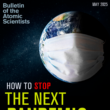I have two responses to Seth Baum’s questions: the first relates to the impact of new technologies on increasing the deterrence value of bioweapons, and the second to the proliferation risk associated with bioweapons development.
Baum asks whether technological advances might alter bioagents, so bioweapons become better deterrents. The short answer is that it’s unlikely due to the nature of the microorganisms used in bioweapons work. Unlike nuclear materials, which have physically predictable properties, living microorganisms are prone to change. As living agents, they mutate, and they are sensitive to environmental and handling conditions. In the US and Soviet programs, for example, scientists found that some strains lost their virulence during manipulation in the laboratory or during dispersion, which compromised their use as a weapon. Laboratory experiments and the production of bioagents were also often subject to unexplained failures, even when highly experienced scientists were involved. The mercurial character of bioagents has not been reduced by new technologies. Currently, gene synthesis companies, which use highly automated processes to produce strands of DNA, routinely yield faulty materials due to errors that can naturally occur in the synthetic process.The pharmaceutical and biotech industries, as well as bioengineering projects, face similar difficulties due to the complexity of living systems. The truth is that in spite of the progress made in understanding the functions and composition of microorganisms, there is still a lot that we don’t know about them, which creates a stiff challenge in the development of viable and stable organisms that can be used predictably an reliably as weapons.
On the proliferation front, biological weapons are indeed complex and difficult to produce, but that does not imply little or no proliferation threat. Nuclear weapons are also very complex and difficult to produce—and yet they pose a proliferation threat. What distinguishes biological weapons is that unlike nuclear weapons, they are not constrained by material acquisition but by the acquisition of specialized skills required to handle and manipulate fragile microorganisms, while maintaining their desirable properties throughout the development process. Yet, most bio-nonproliferation initiatives today are modeled on nuclear nonproliferation efforts, i.e., a primary focus on material acquisition by imposing controls on material and equipment procurement. It is not that such an approach is unimportant but rather that very little is done to target the factors that allow the spread of expertise and the acquisition of specialized knowledge. Hence a major source of proliferation remains under-addressed.
The virtue of the Biological Weapons Convention is that by banning the development of bioweapons, it not only allows the knowledge acquired within past bioweapons programs to erode over time; it also makes it more difficult to create and develop that specialized knowledge. Countries bent on developing bioweapons will have to do so covertly, which requires an organizational and managerial model that is the exact opposite of what is needed for success. The need for covertness has indeed been a key reason for failure in all but the US program. This is why it is important to continue supporting the implementation of the convention: It is indeed one of the few initiatives that target, albeit indirectly, the key barrier to bioweapons development—the acquisition of expertise. (A more detailed analysis of where past programs succeed and where they failed can be found in my book, Barriers to Bioweapons: The Challenges of Expertise and Organization for Weapons Development.)
Share: [addthis tool="addthis_inline_share_toolbox"]














